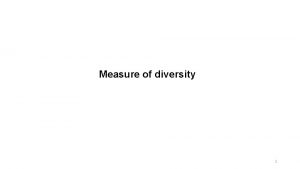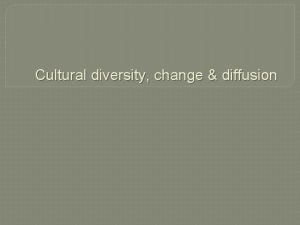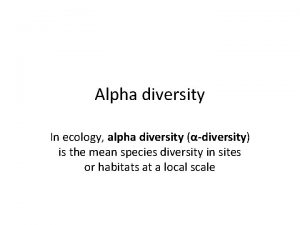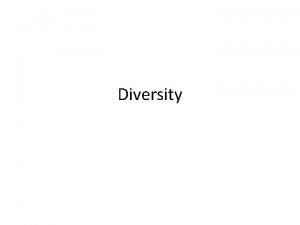Diversity for NonClinical Staff CEClasses com We make




















































- Slides: 52

Diversity for Non-Clinical Staff CE-Classes. com We make staff training requirements easy and affordable TM Di. Dona, Ph. D

Learning Objectives u This course will provide the learner with information regarding cultural competence. A professional will: – Identify cultural awareness and the benefits of cultural competence. – Describe differences in communications across several cultural identities. – Recognize how the RESPECT mnemonic can be used to reinforce culturally responsive attitudes and behaviors. 2

Cultural Competency Why it is Important? u It can improve: – Your u And relationships with others effectiveness in your job ability to get things done when these things happen – Your own life is happier and richer 3

Cultural Competency Why it is Important? u It can also improve – client engagement in services – treatment retention and outcomes. u It is an essential ingredient in your agency’s success with clients. 4

Cultural Competency Why it is Important? u Improves an organization’s sustainability by reinforcing the values of diversity, flexibility, and responsiveness in addressing the current and changing needs of clients. 5

What is Culture u Culture is a conceptual system developed by a community to structure the way people view the world. 6

What is Culture u Culture involves: – A set of beliefs – Norms and – Values. . . u That influence ideas about relationships, how people live and organize their world 7

What is Culture u It is not a obvious entity to which people belong or do not belong. u Within a nation, race, ethnic group or community people belong to multiple cultural groups. 8

What is Culture u The word “culture” is sometimes applied to groups formed on the basis of age, socioeconomic status, disability, sexual orientation, common interest or proximity. 9

What is Culture u Every individual embraces their culture(s) in a unique way and there is considerable diversity within and across races, ethnicities and cultural heritage. 10

What is Race u Race is often referred to as a biological category based on genetic traits like skin color. u However, there are no reliable means of identifying race through biological criteria. 11

What is Race u Race – when defined as a social construct to describe people with shared physical characteristics – has tremendous social significance. 12

Race vs Ethnicity u Ethnicity is often used interchangeably with race – but they are not the same constructs. u Ethnicity implies a sense of belonging and is generally based on shared values, beliefs and origins – not physical characteristics. 13

Cultural Identity u Is the affiliation or identification with a particular group or groups. u It reflects the values, norms and world view of the larger culture – but is defined by more than these factors. 14

Cultural Identity u Includes individual traits and attributes shaped by race, ethnicity, language, religion, life experiences, historical events, acculturation and more. 15

Cultural Competency u Is an ongoing process – not a singular event. u Begins with cultural awareness of one’s own culture. u Next, one must cultivate a willingness to acquire knowledge of the cultures of others. 16

Cultural Awareness u People who are aware of their own cultural backgrounds are more likely to acknowledge and explore other cultures and how culture affects their relationships. 17

Cultural Awareness u Lack of awareness can discount the importance of how your own cultural background (including beliefs, values, and attitudes) influence your – Initial impressions – Interactions and – Effectiveness with others 18

Cultural Awareness u Without cultural awareness, you can unwittingly use your own cultural experiences as a template to prejudge and assess the experiences and intentions of others. 19

How Do You Identify Yourself Cultural competency begins with identifying your own cultural perspective. u How do you describe yourself and which of these do you most heavily identify with: u – Race – Ethnicity – Language – Gender – Sexual orientation – Religion – Political affiliations – Education – Socioeconomic status – and more 20

Cultural Awareness u How do these factors: – Impact your interpersonal relationships? – Influence your choices? – Shape your beliefs and attitudes? – Effect your values? – Color your world view? 21

Cultural Differences u You should avoid assuming that another person has particular – Expectations – Belief systems – Nonverbal and verbal communication – Values, etc. u Based solely on their race, ethnicity, or cultural heritage. 22

Hispanics & Latinos u Hispanic - literally meaning people from Spain or its former colonies u Latino - refers to persons from countries ranging from Mexico to Central & South America and the Caribbean that were colonized by Spain & Portugal u “Latina” refers to a woman of Latino descent. 23

Hispanics as a Group u Latinos are an ethnic rather than a racial group. u Latinos can be of any race. u According to the US Census Bureau, Hispanics are the fastest growing ethnic group (as of 2017 - 18. 1% of the total US population). 24

Cultural Differences in Communication u The following are some examples of general differences among cultural groups: – Individuals from many White/European cultural groups can be uncomfortable with extended silences and may believe that they indicate that nothing is being accomplished (Franks et al. 2000), 25

Cultural Differences in Communication – Whereas Native Americans, who often place great emphasis on the value of listening, can find extended silences appropriate for gathering thoughts or showing that they are open to another’s words (Coyhis, 2005). 26

Cultural Differences in Communication – Latinos often value personalismo (i. e. , warm, genuine communication) in interpersonal relations and value personal rapport in business dealings; – They prefer personal relationships to formal ones (Barón, 2000). 27

Cultural Differences in Communication – Many Latinos also initially engage in plática (small talk) to evaluate the relationship and often use it prior to disclosing more personal information or addressing serious issues (Comas. Diaz, 2012). 28

Cultural Differences in Communication – Asian Americans can be put off by a communication style that is very personal or emotional, and some may lack confidence in a professional whose communication style is too personal (Lee and Mock 2005 a). 29

Cultural Differences in Communication u Some cultural groups are more comfortable with a high degree of verbal confrontation and argument; u Others stress balance and harmony in relationships and shun confrontation. 30

Cultural Differences in Communication – For some, forceful, direct communication can seem rude or disrespectful. – In many Native American and Latino cultural groups, cooperation and agreeableness (simpatía) is valued. – Members often avoid disagreement, contradiction, and disharmony within the group (Sue and Sue 2013 a). 31

Gender Roles u Gender roles are largely cultural constructs; diverse cultural groups have different understandings of the proper roles, attitudes, and behaviors for men and women. 32

Gender Roles u After controlling for income and education, African American women are less accepting than White American women of traditional American gender stereotypes regarding public behavior but more accepting of traditional domestic gender roles (Haynes 2010). 33

Gender Roles u u u In Latino cultural groups, importance is placed on machismo (the belief that men must be strong and protect their families), caballerismo (men’s emotional connectedness), and marianismo (the idea that women should be self-sacrificing, endure suffering for the sake of their families, and defer to their husbands) (Arciniega et al. 2008). 34

Gender Roles u u u These strong gender roles have benefits in Latino culture, such as Simplifying and clarifying roles and responsibilities, but they are also Sources of potential problems, such as limiting help-seeking behavior or the identification of difficulties. 35

Gender Roles u u For example, because of the need to appear in control, a Latino man can have difficulty admitting that he is experiencing psychological distress (Castro et al. 1999 a). For Latinas, the difficulties of negotiating traditional gender roles while encountering new values through acculturation can lead to increased substance use/abuse and mental distress (Mora 2002) 36

Beliefs about Treatment u In general, Latino attitudes toward health care shaped by a lack of access to regular quality care, including inability to afford it (Rogers 2010). u De. Navas-Walt et al. (2006) found that Latinos are less likely to have health insurance than either non-Latino White Americans or African Americans. 37

Beliefs about Treatment u Factors that influence the use of medical services for Hispanics, include: – Cultural health beliefs, – Demographic barriers, – Level of acculturation, – English proficiency, – Accessibility of service providers, and – Flexibility of intake procedures; 38

Beliefs about Treatment u Lack of knowledge about available services can be a major obstacle for Hispanics and African Americans. u Many Latinos only seek medical care for serious illnesses 39

Cultural Competence u How do we demonstrate to others that we are sensitive to their cultural, beliefs and values? 40

RESPECT u The RESPECT mnemonic can be used to reinforce culturally responsive attitudes and behaviors. 41

RESPECT – Respect – Explanatory model – Sociocultural context – Power – Empathy – Concerns and fears – Therapeutic Alliance / trust 42

RESPECT u Respect—Understand how respect is shown within given cultural groups. – You can demonstrate this attitude through verbal and nonverbal communications. 43

RESPECT u Explanatory model—Devote time to understanding how others perceive things and their problems. – What are their views about their own life, relationships, needs or problems? – How similar or different is your perspective? 44

RESPECT u Sociocultural context – Recognize how class, race, ethnicity, gender, education, socioeconomic status, sexual and gender orientation, immigrant status, community, family, gender roles, and so forth affect their lives. 45

RESPECT u Power—Acknowledge the power differential between people – especially when you are in a position of power. 46

RESPECT u Empathy—caring concern for another person - express this verbally and nonverbally - so that the other person feels understood. 47

RESPECT u Concerns and fears—Elicit the other person’s concerns and apprehensions. – This is especially important when helpseeking behavior occurs – for example at the initiation of treatment. 48

RESPECT u Therapeutic Alliance/Trust— Commit to behaviors that enhance relationships; recognize that trust is not inherent but must be earned. 49

Cultural Competency u Is an ongoing process. u Begins with cultural awareness of one’s own culture. u Remember to ask others questions about their beliefs and values. u Enjoy the process of learning. u You are very likely to be happier yourself when you accept others. 50

References u u u u u Alegria, M. Immigration-related factors and mental disorders among Asian Americans. American Journal of Public Health 97(1): 84– 90, 2007. Arciniega, G. M. , Anderson, T. C. , Tovar-Blank, Z. G. , and Tracey, T. J. G. Toward a fuller conception of Machismo: Development of a traditional Machismo and Caballerismo Scale. Journal of Counseling Psychology 55(1): 19– 33, 2008. Barón, M. Addiction treatment for Mexican American families. In: Krestan, J. A. , ed. Bridges to Recovery: Addiction, Family Therapy, and Multicultural Treatment (pp. 219– 252). New York: The Free Press, 2000. Castro, F. G. , Nichols, E. , and Kater, K. Relapse prevention with Hispanic and other racial/ethnic populations: Can cultural resilience promote relapse prevention? In: Witkiewitz, K. A. , and Marlatt, G. A. , eds. Therapist’s Guide to Evidence-Based Relapse Prevention: Practical Resources for the Mental Health Professional (pp. 259– 292). Boston: Elsevier Academic Press, 2007. Comas-Diaz, L. Multicultural Care: A Clinician’s Guide to Cultural Competence (pp. 33– 56). Washington, DC: American Psychological Association, 2012. Coyhis, D. , and Simonelli, R. Rebuilding Native American communities. Child Welfare 84(2): 323– 336, 2005. De. Navas-Walt, C. , Proctor, B. D. , and Lee, C. H. Income, Poverty, and Health Insurance Coverage in the United States: 2005. (pp. 60– 229). Washington, DC: U. S. Government Printing Office Fiorentine, R. , and Hillhouse, M. P. Drug treatment effectiveness and client-counselor empathy: Exploring the effects of gender and ethnic congruency. Journal of Drug Issues 29(1): 59– 74, 1999. Franks, P. H. Silence/Listening and Intercultural Differences. Presented at the Twenty-First Annual International Listening Association Convention. March 8, 2000. Virginia Beach, VA, 2000. Garcia-Preto, N. , eds. Ethnicity and Family Therapy. 3 rd ed. (pp. 269– 289). New York: Guilford Press, 2005 a. 51

References u u u Haynes, F. E. Gender and family ideals: An exploratory study of Black middle-class Americans. Journal of Family Issues 21(7): 811– 837, 2000. Ishikawa, R. Z. , Cardemil, E. V. , and Falmagne, R. J. Help seeking and help receiving for emotional distress among Latino men and women. Qualitative Health Research 20(11): 1558– 1572, 2010. Iwamasa, G. Y. , eds. Culturally Responsive Cognitive–Behavioral Therapy: Assessment, Practice, and Supervision (pp. 73– 96). Washington, DC: American Psychological Association, 2006. Lee, E. , and Mock, M. R. Chinese families. In: Mc. Goldrick, M. , Giordano, J. , and Garcia-Preto, N. , eds. Ethnicity and Family Therapy. 3 rd ed. (pp. 302– 318). New York: Guilford Press, 2005 b. Mora, J. Latinas in cultural transition: Addiction, treatment and recovery. In: Straussner, S. L. A. , and Brown, S. , eds. The Handbook of Addiction Treatment for Women: Theory and Practice (pp. 323– 347). San Francisco: Jossey Bass, 2002. Organista, K. C. Cognitive–behavioral therapy with Latinos and Latinas. In: Hays, P. A. , and Rogers, A. T. Exploring health beliefs and care-seeking behaviors of older USA-dwelling Mexicans and Mexican-Americans. Ethnicity & Health 15(6): 581– 599, 2010. Substance Abuse and Mental Health Services Administration. Improving Cultural Competence. Treatment Improvement Protocol (TIP) Series No. 59. HHS Publication No. (SMA) 14 -4849. Rockville, MD: Substance Abuse and Mental Health Services Administration, 2014. Sue, D. W. , and Sue, D. Counseling the Culturally Diverse: Theory and Practice. 5 th ed. Hoboken, NJ: John Wiley & Sons, 2008 Sue, D. W. , and Sue, D. The politics of counseling and psychotherapy (pp. 33– 62). In: Counseling the Culturally Diverse: Theory and Practice. 4 th ed. New York: John Wiley and Sons, 2003 b. Takeuchi, D. T. , Sue, S. , and Yeh, M. Return rates and outcomes from ethnicity-specific mental health programs in Los Angeles. American Journal of Public Health 85(5): 638– 643, 1995. 52
 Cơm
Cơm Bài thơ mẹ đi làm từ sáng sớm
Bài thơ mẹ đi làm từ sáng sớm Genetic diversity and biodiversity
Genetic diversity and biodiversity Ecosystem jigsaw activity
Ecosystem jigsaw activity Inköpsprocessen steg för steg
Inköpsprocessen steg för steg Påbyggnader för flakfordon
Påbyggnader för flakfordon Tack för att ni lyssnade
Tack för att ni lyssnade Egg för emanuel
Egg för emanuel Atmosfr
Atmosfr Varför kallas perioden 1918-1939 för mellankrigstiden
Varför kallas perioden 1918-1939 för mellankrigstiden Rutin för avvikelsehantering
Rutin för avvikelsehantering Var finns arvsanlagen
Var finns arvsanlagen Presentera för publik crossboss
Presentera för publik crossboss Myndigheten för delaktighet
Myndigheten för delaktighet Debattartikel mall
Debattartikel mall Var 1721 för stormaktssverige
Var 1721 för stormaktssverige Tack för att ni har lyssnat
Tack för att ni har lyssnat A gastrica
A gastrica Tobinskatten för och nackdelar
Tobinskatten för och nackdelar Referatmarkeringar
Referatmarkeringar Novell typiska drag
Novell typiska drag Verifikationsplan
Verifikationsplan Frger
Frger Epiteltyper
Epiteltyper Rbk-mätning
Rbk-mätning Tryck formel
Tryck formel Vilka tal pekar pilarna på
Vilka tal pekar pilarna på Elektronik för barn
Elektronik för barn Borra hål för knoppar
Borra hål för knoppar En lathund för arbete med kontinuitetshantering
En lathund för arbete med kontinuitetshantering Smärtskolan kunskap för livet
Smärtskolan kunskap för livet Bris för vuxna
Bris för vuxna Vad är ett minoritetsspråk
Vad är ett minoritetsspråk Trög för kemist
Trög för kemist Magnetsjukhus
Magnetsjukhus Humanitr
Humanitr Vad är densitet
Vad är densitet Blomman för dagen drog
Blomman för dagen drog Redogör för vad psykologi är
Redogör för vad psykologi är Tack för att ni lyssnade bild
Tack för att ni lyssnade bild Mat för idrottare
Mat för idrottare Skapa med geometriska former
Skapa med geometriska former Bästa kameran för astrofoto
Bästa kameran för astrofoto Lyrik texte
Lyrik texte Ledarskapsteorier
Ledarskapsteorier Offentlig förvaltning
Offentlig förvaltning Fredsgudinna pax
Fredsgudinna pax Underlag för särskild löneskatt på pensionskostnader
Underlag för särskild löneskatt på pensionskostnader Rita perspektiv
Rita perspektiv Orubbliga rättigheter
Orubbliga rättigheter Bamse för de yngsta
Bamse för de yngsta Ministerstyre för och nackdelar
Ministerstyre för och nackdelar Tillitsbaserad ledning
Tillitsbaserad ledning












































































